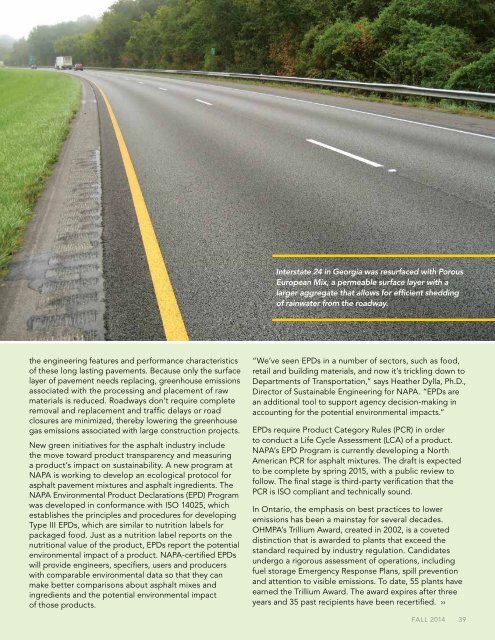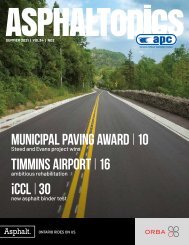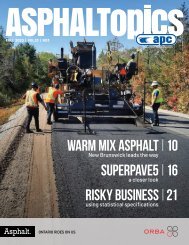ASPHALTopics | Summer 2014 | VOL 27 | NO3
Create successful ePaper yourself
Turn your PDF publications into a flip-book with our unique Google optimized e-Paper software.
Interstate 24 in Georgia was resurfaced with Porous<br />
European Mix, a permeable surface layer with a<br />
larger aggregate that allows for efficient shedding<br />
of rainwater from the roadway.<br />
the engineering features and performance characteristics<br />
of these long lasting pavements. Because only the surface<br />
layer of pavement needs replacing, greenhouse emissions<br />
associated with the processing and placement of raw<br />
materials is reduced. Roadways don’t require complete<br />
removal and replacement and traffic delays or road<br />
closures are minimized, thereby lowering the greenhouse<br />
gas emissions associated with large construction projects.<br />
New green initiatives for the asphalt industry include<br />
the move toward product transparency and measuring<br />
a product’s impact on sustainability. A new program at<br />
NAPA is working to develop an ecological protocol for<br />
asphalt pavement mixtures and asphalt ingredients. The<br />
NAPA Environmental Product Declarations (EPD) Program<br />
was developed in conformance with ISO 14025, which<br />
establishes the principles and procedures for developing<br />
Type III EPDs, which are similar to nutrition labels for<br />
packaged food. Just as a nutrition label reports on the<br />
nutritional value of the product, EPDs report the potential<br />
environmental impact of a product. NAPA-certified EPDs<br />
will provide engineers, specifiers, users and producers<br />
with comparable environmental data so that they can<br />
make better comparisons about asphalt mixes and<br />
ingredients and the potential environmental impact<br />
of those products.<br />
“We’ve seen EPDs in a number of sectors, such as food,<br />
retail and building materials, and now it’s trickling down to<br />
Departments of Transportation,” says Heather Dylla, Ph.D.,<br />
Director of Sustainable Engineering for NAPA. “EPDs are<br />
an additional tool to support agency decision-making in<br />
accounting for the potential environmental impacts.”<br />
EPDs require Product Category Rules (PCR) in order<br />
to conduct a Life Cycle Assessment (LCA) of a product.<br />
NAPA’s EPD Program is currently developing a North<br />
American PCR for asphalt mixtures. The draft is expected<br />
to be complete by spring 2015, with a public review to<br />
follow. The final stage is third-party verification that the<br />
PCR is ISO compliant and technically sound.<br />
In Ontario, the emphasis on best practices to lower<br />
emissions has been a mainstay for several decades.<br />
OHMPA’s Trillium Award, created in 2002, is a coveted<br />
distinction that is awarded to plants that exceed the<br />
standard required by industry regulation. Candidates<br />
undergo a rigorous assessment of operations, including<br />
fuel storage Emergency Response Plans, spill prevention<br />
and attention to visible emissions. To date, 55 plants have<br />
earned the Trillium Award. The award expires after three<br />
years and 35 past recipients have been recertified. ››<br />
FALL <strong>2014</strong> 39


















